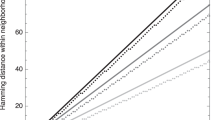Abstract
We study the evolution of large but finite asexual populations evolving in fitness landscapes in which all mutations are either neutral or strongly deleterious. We demonstrate that despite the absence of higher fitness genotypes, adaptation takes place as regions with more advantageous distributions of neutral genotypes are discovered. Since these discoveries are typically rare events, the population dynamics can be subdivided into separate epochs, with rapid transitions between them. Within one epoch, the average fitness in the population is approximately constant. The transitions between epochs, however, are generally accompanied by a significant increase in the average fitness. We verify our theoretical considerations with two analytically tractable bitstring models.
Similar content being viewed by others
References
Adami, C. (1995). Self-organized critically in living systems. Phys. Lett. A 203, 29–32.
Charlesworth, B. (1990). Mutation-selection balance and the evolutionary advantage of sex and recombination. Genet. Res. Camb. 55, 199–221.
Crow, J. F. (1970). Genetic loads and the cost of natural selection, in Mathematical Topics in Population Genetics, K. Kojima (Ed.), Berlin: Springer-Verlag, pp. 128–177.
Derrida, B. and L. Peliti (1991). Evolution in a flat fitness landscape. Bull. Math. Biol. 53, 355–382.
Dress, A. W. M. and D. S. Rumschitzki (1988). Evolution on sequence space and tensor products of representation spaces. Acta Applicandae Mathematicae 11, 103–115.
Eigen, M., J. McCaskill and P. Schuster (1988). Molecular quasi-species. J. Phys. Chem. 92, 6881–6891.
Eigen, M., J. McCaskill and P. Schuster (1989). The molecular quasi-species. Adv. Chem. Phys. 75, 149–263.
Eigen, M. and P. Schuster (1979). The Hypercycle—A Principle of Natural Self-Organization, Berlin: Springer-Verlag.
Eldredge, N. and S. J. Gould (1972). Punctuated equilibria: and alternative to phyletic gradualism, in Models in Paleobiology, T. J. M. Schopf (Ed.), San Francisco: Freeman, pp. 82–115.
Elena, S. F., V. S. Cooper and R. E. Lenski (1996). Punctuated evolution caused by selection of rare beneficial mutations. Science 272, 1802–1804.
Fontana, W. and P. Schuster (1998). Continuity in evolution: on the nature of transitions. Nature 280, 1451–1455.
Forst, C. V., C. Reidys and J. Weber (1995). Evolutionary dynamics and optimization: Neutral Networks as model-landscape for RNA secondary-structure folding-landscapes, in Advances in Artificial Life, 929 of Lecture Notes in Artificial Intelligence, F. Morán, A. Moreno, J. J. Merelo and P. Chacón (Eds), pp. 128–147.
Gavrilets, S. (1997). Evolution and speciation on holey adaptive landscapes. TREE 12, 307–312.
Gavrilets, S. (1999). A dynamical theory of speciation on holey adaptive landscapes. Am. Nat. 154, 1–22.
Gould, S. J. and N. Eldredge (1977). Punctuated equilibria: the tempo and mode of evolution reconsidered. Paleobiology 3, 115–151.
Haldane, J. B. S. (1927). A mathematical theory of natural and artificial selection. Part V: Selection and mutation. Proc. Camp. Phil. Soc. 23, 838–844.
Haldane, J. B. S. (1937). The effect of variation on fitness. Am. Nat. 71, 337–349.
Huynen, M. A., P. F. Stadler and W. Fontana (1996). Smoothness within ruggedness: The role of neutrality in adaptation. Proc. Natl. Acad. Sci. USA 93, 397–401.
Kimura, M. (1964). Diffusion models in population genetics. J. Appl. Prob. 1, 177–232.
Kimura, M. and T. Maruyama (1966). The mutational load with epistatic gene interactions in fitness. Genetics 54, 1337–1351.
Kondrashov, A. S. (1988). Deleterious mutations and the evolution of sexual reproduction. Nature 336, 435–440.
Lenski, R. E. and M. Travisano (1994). Dynamics of adaptation and diversification: a 10,000-generation experiment with bacterial populations. Proc. Natl Acad. Sci. USA 91, 6808–6814.
Muller, H. J. (1950). Our load of mutations. Am. J. Hum. Genet. 2, 111–176.
Nowak, M. A. (1992). What is a quasispecies? TREE 7, 118–121.
Ofria, C., C. Adami and T. C. Collier (2000). Selective pressures on genomes in evolution, unpublished.
Rumschitzki, D. S. (1987). Spectral properties of Eigen evolution matrices. J. Math. Biol. 24, 667–680.
Schuster, P. and J. Swetina (1988). Stationary mutant distributions and evolutionary optimization. Bull. Math. Biol. 50, 635–660.
Swetina, J. and P. Schuster (1982). Self-replication with errors: a model for polynucleotide replication. Biophys. Chem. 16, 329–345.
van Nimwegen, E. and J. P. Crutchfield (2000a). Metastable evolutionary dynamics: Crossing fitness barriers or escaping via neutral paths? Bull. Math. Biol. 62, 799–848.
van Nimwegen, E. and J. P. Crutchfield (2000b). Optimizing epochal evolutionary search: population-size independent theory. Comput. Methods. Appl. Mech. Eng. 186, 171–194.
van Nimwegen, E., J. P. Crutchfield and M. Huynen (1999a). Neutral evolution of mutational robustness. Proc. Natl Acad. Sci. USA 96, 9716–9720.
van Nimwegen, E., J. P. Crutchfield and M. Mitchell (1997). Finite populations induce metastability in evolutionary search. Phys. Lett. 229, 144–150.
van Nimwegen, E., J. P. Crutchfield and M. Mitchell (1999b). Statistical dynamics of the royal road genetic algorithm. Theor. Comput. Sci. 229, 41–102.
Vose, M. D. and G. E. Liepins (1991). Punctuated equilibria in genetic search. Complex Syst. 5, 31–44.
Wilke, C. O. (1999). Evolutionary dynamics in time-dependent environments, PhD thesis, Ruhr-Universität Bochum, Aachen: Shaker-Verlag.
Wilke, C. O. and C. Adami (2001). Interaction between directional epistasis and average mutational effects. Proc. R. Soc. London B, in press.
Wilke, C. O., C. Ronnewinkel and T. Martinetz (2001). Dynamic fitness landscapes in molecular evolution. Phys. Rep., in press.
Wilke, C. O., J. L. Wang, C. Ofria, R. E. Lenski and C. Adami (2001). Evolution of digital organisms at high mutation rate leads to survival of the flattest. Nature, in press.
Author information
Authors and Affiliations
Rights and permissions
About this article
Cite this article
Wilke, C.O. Adaptive evolution on neutral networks. Bull. Math. Biol. 63, 715–730 (2001). https://doi.org/10.1006/bulm.2001.0244
Received:
Accepted:
Issue Date:
DOI: https://doi.org/10.1006/bulm.2001.0244




